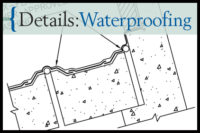
Typical
termination with adjusted pedestal at a wall, parapet or curb. Illustrations
courtesy of American Hydrotech, Inc.
The most critical component of paver application on sloped surfaces is the correct adjustment of the pedestals. Adjustments of the pedestals are required to provide a uniform and level paver height while adjusting for changes in substrate height based on slope. Typically maintaining paver uniformity when there are slope variances can be accomplished through adjustments to the pedestals. In some instances, a shim may be required for minor adjustments.

The pedestal and paver systems should be applied over EPS insulation that has a minimum compressive strength of 60 psi.
The detail provided illustrates application of the paver and pedestal system at vertical transitions such as walls, parapets or curbs. In these cases, the transverse spacer lugs are left intact to allow for the joint space termination.




